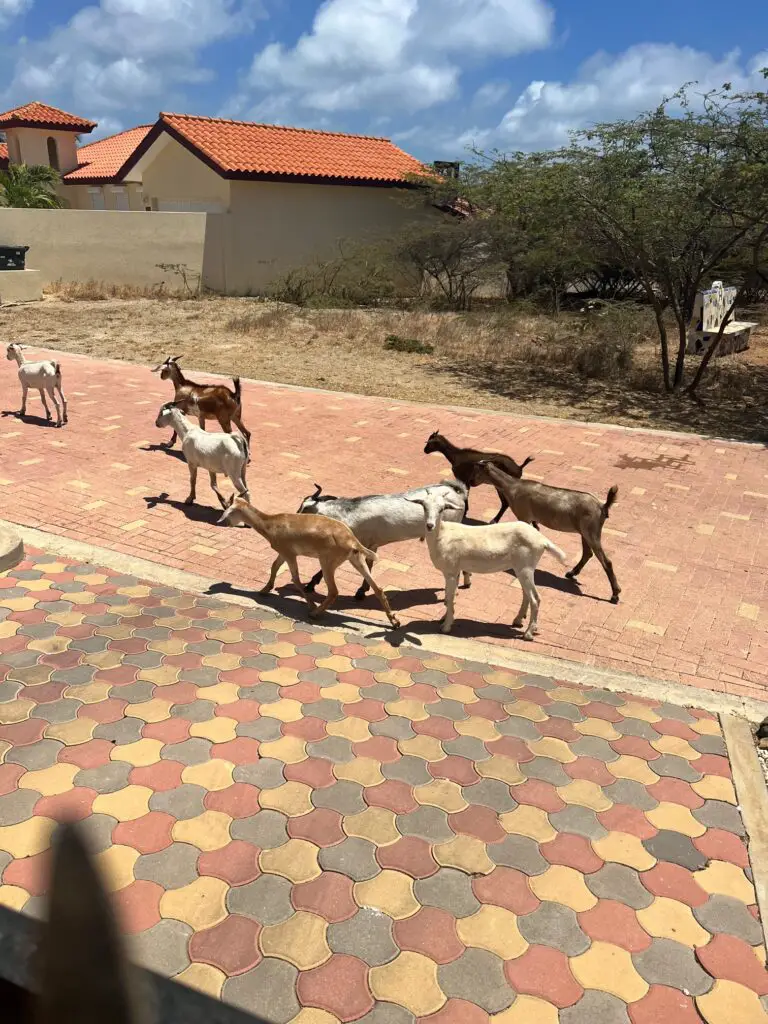
I travelled to Aruba in June 2023. I didn’t go there just for the goats (more for the beaches!) but I did take advantage of being in the proximity of these amazing animals to capture some great goat pix and video and to learn first hand about them.
The island of Aruba is home to a population of wild goats. These goats are not native to the island, but were introduced by humans centuries ago. The exact date of their arrival is unknown, but it is believed that they were brought over by Spanish settlers in the 1600s.
The goats quickly adapted to their new environment and thrived on the island. They are expert foragers, reproduced rapidly, and their numbers soon grew to the point where they were considered a nuisance by many residents. In an effort to control the population, the Aruban government began a program of hunting and culling the goats in the early 1900s. This program was largely successful and by the mid-1900s, the goat population had been greatly reduced.
Table of contents
- Origins of Aruba’s Goats
- Goats in Aruba’s Economy
- The Role of Goats in Aruban Culture
- Goats as a Status Symbol in Aruba
- Managing the Aruban Goat Population
- The Future of Goats in Aruba
- Common Breeds of Goats Found in Aruba
- Conserving the Aruban Goats
- Popular Names for Goats in Aruba
- Video: Aruba Goats
- FAQ
In recent years, however, the wild goat population has begun to rebound. Thanks to a combination of protective measures and a lack of hunting pressure, the goats are once again becoming a common sight on Aruba. Though they are still considered pests by some, these playful and curious creatures are an important part of Aruba’s history and ecosystem.
Origins of Aruba’s Goats
Most people think of goats as being domesticated animals that are kept on farms, but there are actually plenty of wild goats in the world. One place you can find them is on the island of Aruba. But how did they get there?
There are a few theories about how goats first came to Aruba. One is that they were brought over by Spanish explorers in the 16th century. Another is that they were introduced by the Dutch in the 17th century.
Whatever their origins, the goats have certainly made themselves at home on the island. They can be found roaming around in the wild, and they’re even known to swim out to the nearby islands of Bonaire and Curacao.
So why are there so many goats on Aruba? Well, there’s no official hunting season for them, so they’re not hunted for food. And because there’s no natural predators on the island, they’ve been able to thrive.
The goats are actually quite friendly, and they’re often seen grazing near the beaches. But they can be a bit pesky, and they’re known to steal food from unsuspecting tourists.
If you’re ever in Aruba, be sure to keep an eye out for the wild goats. They’re sure to make your vacation even more memorable!
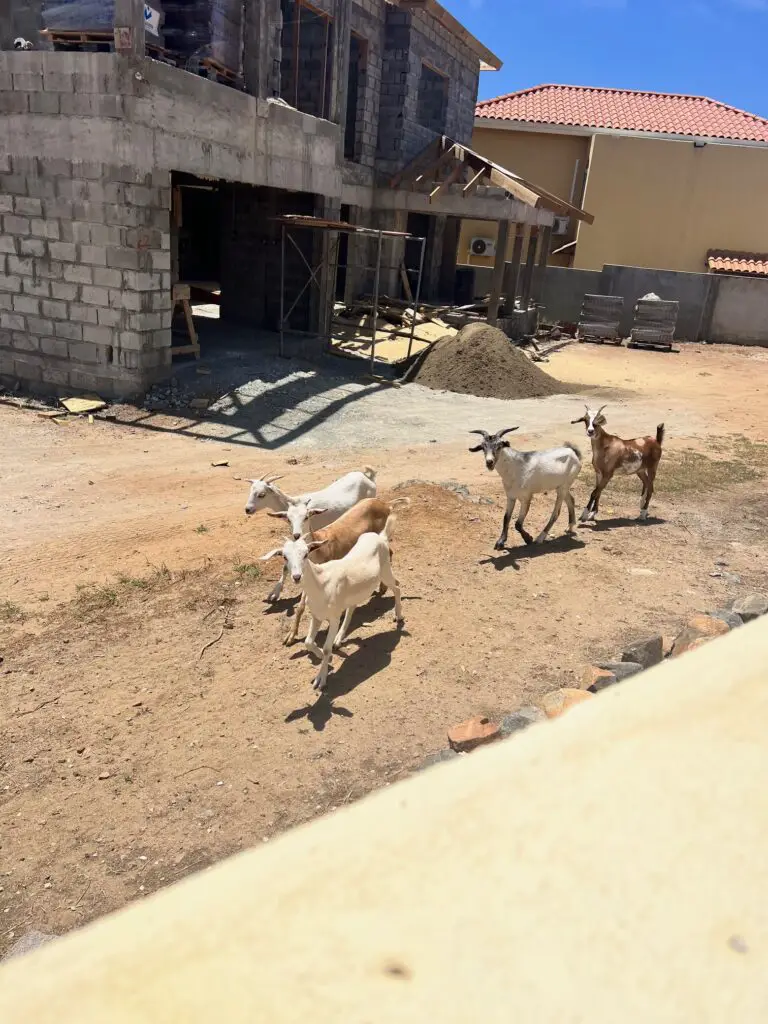
Goats in Aruba’s Economy
The island of Aruba is home to a thriving economy, and a big part of that is thanks to the goats that live there! The goats are a key part of the agricultural industry on the island, and they provide a valuable resource that helps to keep the economy strong.
The goats are used for their milk, which is used to make cheese and other dairy products. The cheese that is made on the island is some of the best in the world, and it is exported to other countries to help boost the economy. The goats also provide meat for the island, and their skins are used to make leather goods.
The goats are an important part of the Aruban economy, and they are a key part of the island’s history and culture. There are even a few Goat Festivals that are held every year to celebrate the goats and their contribution to the island. If you ever visit Aruba, be sure to try some of the cheese and other products made from the goats, and maybe even attend one of the festivals!
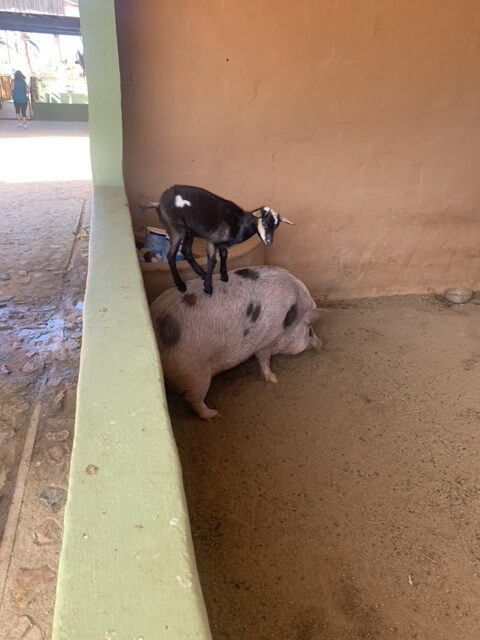
The Role of Goats in Aruban Culture
Goats in Aruba are not just another farm animal. They are an essential part of Aruban culture and have been for centuries. Goats were brought to the island by the Spanish in the 16th century and have been a part of Aruban life ever since.
Wild goats are a common sight in Aruba and can be found roaming in the mountains and scrubland. They are also a popular choice of farm animal, as they are hardy and can survive in harsh conditions.
Goats play an important role in Aruban culture, particularly in terms of food and religion. Goat meat is a popular choice for traditional dishes such as stews and curries. Goat’s milk is also used to make cheese and other dairy products.
In terms of religion, goats are seen as lucky animals and are often used in ceremonial sacrifices. A goat’s death is considered to be a powerful offering to the gods and can bring good fortune to those who make the sacrifice.
So, next time you see a goat in Aruba, remember that they are more than just another farm animal. They are an important part of the island’s culture and have been for centuries.
Goats as a Status Symbol in Aruba
Aruba is an island country in the Caribbean Sea, and is home to a unique species of goat. The Aruban goat is a wild goat that is found only on the island of Aruba. These goats are considered to be a status symbol by the people of Aruba.
The Aruban goat is a medium-sized goat, with a reddish-brown coat and white spots. They are able to climb trees and cliffs, and are often seen grazing on the vegetation of Aruba. The goats are also known to be good swimmers, and have been known to swim from one island to another.
The Aruban goat is a symbol of strength and resilience, and is considered to be a good luck charm by the people of Aruba. They are often seen as a status symbol, and are kept as pets by many families on the island.
Managing the Aruban Goat Population
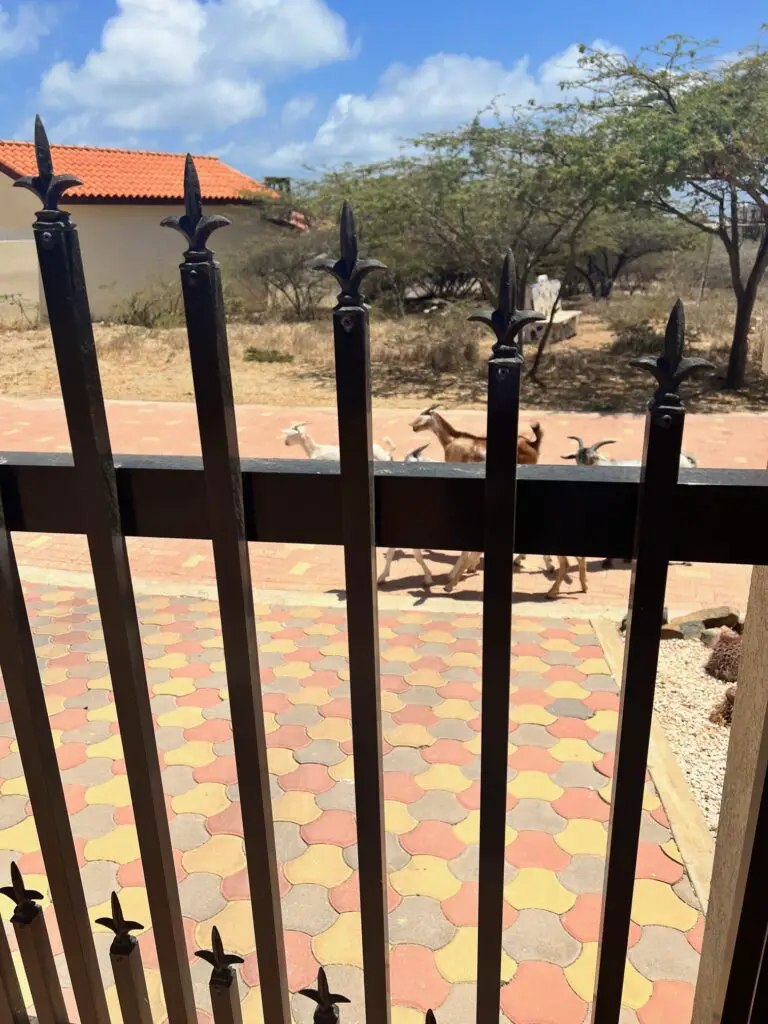
The island of Aruba is home to a population of wild goats. These goats are a source of food for many residents of Aruba, and they are also a source of income for the island’s economy.
The goats are managed by the Aruban government. The government sets aside areas of the island for the goats to graze. The government also regulates the hunting of goats. Hunting is only allowed during certain times of the year, and only certain parts of the goat can be harvested.
The government also manages the exporting of goats. Goats are exported to other islands in the Caribbean, and to the United States. The goats are used for their meat, and for their skin. The skin of the goats is used to make drums.
The management of the Aruban goat population is important for the island’s economy and for the people who rely on the goats for food.
The Future of Goats in Aruba
There’s no denying that goats are an important part of the Aruban landscape. Goats have been a part of the island for centuries, and they’re not going anywhere anytime soon. But what is the future of goats in Aruba?
As the human population of Aruba continues to grow, there is an increasing demand for goat meat. In fact, goat is the most popular meat on the island. While there are currently enough goats to meet this demand, the future of goats in Aruba is uncertain.
The main problem is that there is not enough land to support a growing goat population. As more and more land is developed for houses and businesses, there is less and less space for goats to roam. This could lead to a decrease in the goat population, as there are simply not enough resources to support them.
Another issue facing goats in Aruba is climate change. The island is already quite hot, and as the climate continues to warm, it will become even more difficult for goats to survive. This could lead to a decline in the goat population, as they will struggle to find food and water.
The future of goats in Aruba is uncertain, but there are steps that can be taken to ensure their survival. First, we need to protect the remaining land area that is available for them to roam. Second, we need to help them adapt to the changing climate. Only by taking these steps can we ensure that goats will be a part of the Aruban landscape for centuries to come.
Common Breeds of Goats Found in Aruba
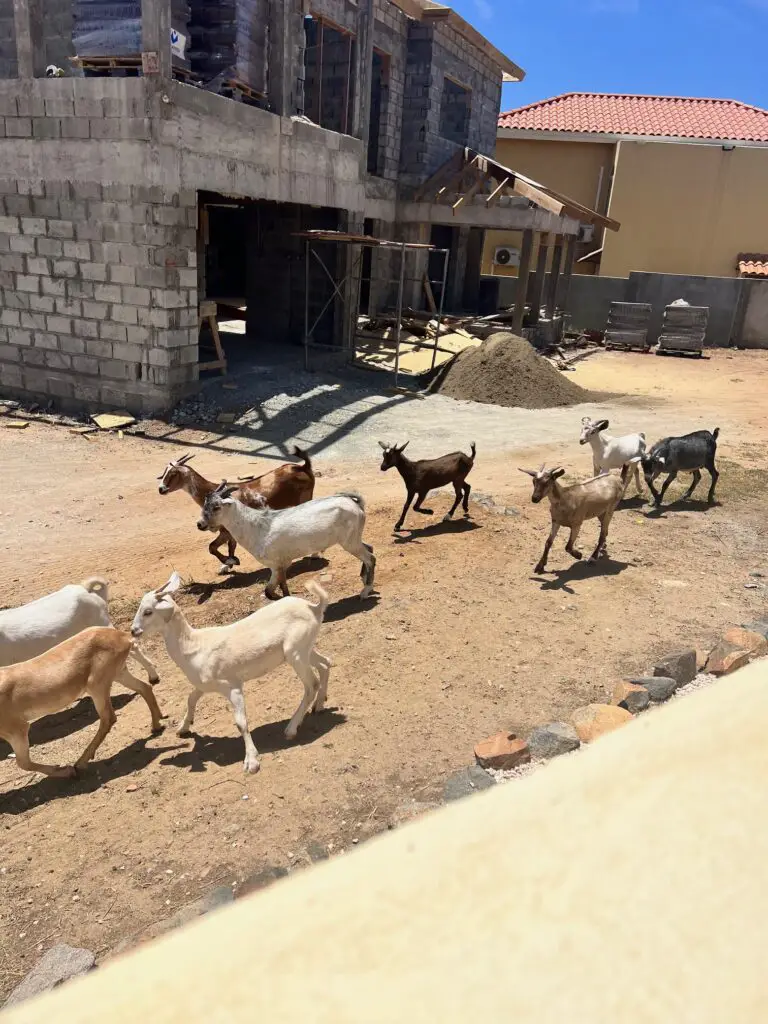
There are many different types of goats found in Aruba. Some of the more common breeds include the following:
- Toggenburg: The Toggenburg is a Swiss breed of dairy goat. It is named after the Toggenburg region of Switzerland. It is black and white in color and is one of the oldest dairy goat breeds.
- Alpine: The Alpine is a French breed of dairy goat. It is characterized by its large size, long body, and upright posture. It is black, white, or brown in color.
- Nubian: The Nubian is a goat breed from Africa. It is characterized by its large size, long ears, and wrinkled face. It is black, brown, or white in color.
- LaMancha: The LaMancha is an American breed of dairy goat. It is characterized by its small size and lack of ears. It is black, brown, or white in color.
- Saanen: The Saanen is a Swiss breed of dairy goat. It is characterized by its large size and pure white color.
- Oberhasli: The Oberhasli is a Swiss breed of dairy goat. It is characterized by its reddish-brown color and black markings on its head and legs.
- Boer: The Boer is a South African breed of goat. It is characterized by its large size and white color with red markings on its head and legs.
- Angora: The Angora is a Turkish breed of goat. It is characterized by its long, soft hair. It is white, black, or gray in color.
- Pygmy: The Pygmy is a Nigerian breed of dwarf goat. It is characterized by its small size and black color.
Conserving the Aruban Goats
Conserving the Aruban Goats
The island of Aruba is home to a unique population of wild goats. These goats are an important part of the island’s ecosystem and play a vital role in the health of the local vegetation. Unfortunately, the population of wild goats is under threat.
There are a number of reasons why the wild goat population is declining. One of the biggest threats is habitat loss. As the island of Aruba continues to develop, more and more natural habitat is being lost to development. This is especially true in the coastal areas where the goats live.
Another big threat to the goats is hunting. Even though hunting wild goats is illegal on the island, it still occurs. Some people hunt goats for food, while others do it for sport. Either way, it is having a negative impact on the population.
Fortunately, there are a number of conservation efforts underway to help protect the wild goats of Aruba. One of the most important things being done is educating people about the importance of these animals and why they need to be protected.
The wild goats of Aruba are an important part of the island’s ecosystem and deserve our protection. With proper management and conservation efforts, we can ensure that these goats will be around for future generations to enjoy.

Popular Names for Goats in Aruba
Popular Names for Goats in Aruba
Here are a few of the most popular names for goats in Aruba, along with their meaning and origin:
- Boali: This name comes from the Dutch word for “goat”, which is “bok”.
- Daisy: This name is derived from the flower of the same name.
- Fena: This name means “wild” or “untamed” in the local dialect.
- Laca: This name is the feminine form of “lac” which means “male goat”.
- Maya: This name means “mother” in the local dialect.
- Mimi: This name is derived from the French word for “goat”, which is “chèvre”.
- Nena: This name means “girl” or “daughter” in the local dialect.
- Sofia: This name is derived from the Greek word for “goat”, which is “πάππος” (pappos).
- Tina: This name is derived from the Spanish word for “goat”, which is “cabra”.
- Zora: This name means “light” or “sunshine” in the local dialect.
Video: Aruba Goats
In the video below, you can see one of the cute baby goats that live on Aruba. This little guy was using a very patient pig as a stepping stool.
FAQ
No one knows for sure. Some think that the Dutch brought them in the 17th century. Other people think that they arrived far earlier, in the 16th century, and were brought by Spanish explorers.
The short answer is yes. Anywhere that isn’t goat proof will get goat visitors!
Not at all. Take a look at the images and videos in this post; if you wanted to get hurt by a goat on Aruba you would have to find a group of them running and maybe lay down in front of them.




